Yuqi Zhang
AMIA: Automatic Masking and Joint Intention Analysis Makes LVLMs Robust Jailbreak Defenders
May 30, 2025Abstract:We introduce AMIA, a lightweight, inference-only defense for Large Vision-Language Models (LVLMs) that (1) Automatically Masks a small set of text-irrelevant image patches to disrupt adversarial perturbations, and (2) conducts joint Intention Analysis to uncover and mitigate hidden harmful intents before response generation. Without any retraining, AMIA improves defense success rates across diverse LVLMs and jailbreak benchmarks from an average of 52.4% to 81.7%, preserves general utility with only a 2% average accuracy drop, and incurs only modest inference overhead. Ablation confirms both masking and intention analysis are essential for a robust safety-utility trade-off.
Transformer representation learning is necessary for dynamic multi-modal physiological data on small-cohort patients
Apr 05, 2025



Abstract:Postoperative delirium (POD), a severe neuropsychiatric complication affecting nearly 50% of high-risk surgical patients, is defined as an acute disorder of attention and cognition, It remains significantly underdiagnosed in the intensive care units (ICUs) due to subjective monitoring methods. Early and accurate diagnosis of POD is critical and achievable. Here, we propose a POD prediction framework comprising a Transformer representation model followed by traditional machine learning algorithms. Our approaches utilizes multi-modal physiological data, including amplitude-integrated electroencephalography (aEEG), vital signs, electrocardiographic monitor data as well as hemodynamic parameters. We curated the first multi-modal POD dataset encompassing two patient types and evaluated the various Transformer architectures for representation learning. Empirical results indicate a consistent improvements of sensitivity and Youden index in patient TYPE I using Transformer representations, particularly our fusion adaptation of Pathformer. By enabling effective delirium diagnosis from postoperative day 1 to 3, our extensive experimental findings emphasize the potential of multi-modal physiological data and highlight the necessity of representation learning via multi-modal Transformer architecture in clinical diagnosis.
Goku: Flow Based Video Generative Foundation Models
Feb 10, 2025



Abstract:This paper introduces Goku, a state-of-the-art family of joint image-and-video generation models leveraging rectified flow Transformers to achieve industry-leading performance. We detail the foundational elements enabling high-quality visual generation, including the data curation pipeline, model architecture design, flow formulation, and advanced infrastructure for efficient and robust large-scale training. The Goku models demonstrate superior performance in both qualitative and quantitative evaluations, setting new benchmarks across major tasks. Specifically, Goku achieves 0.76 on GenEval and 83.65 on DPG-Bench for text-to-image generation, and 84.85 on VBench for text-to-video tasks. We believe that this work provides valuable insights and practical advancements for the research community in developing joint image-and-video generation models.
The Energy Loss Phenomenon in RLHF: A New Perspective on Mitigating Reward Hacking
Jan 31, 2025



Abstract:This work identifies the Energy Loss Phenomenon in Reinforcement Learning from Human Feedback (RLHF) and its connection to reward hacking. Specifically, energy loss in the final layer of a Large Language Model (LLM) gradually increases during the RL process, with an excessive increase in energy loss characterizing reward hacking. Beyond empirical analysis, we further provide a theoretical foundation by proving that, under mild conditions, the increased energy loss reduces the upper bound of contextual relevance in LLMs, which is a critical aspect of reward hacking as the reduced contextual relevance typically indicates overfitting to reward model-favored patterns in RL. To address this issue, we propose an Energy loss-aware PPO algorithm (EPPO) which penalizes the increase in energy loss in the LLM's final layer during reward calculation to prevent excessive energy loss, thereby mitigating reward hacking. We theoretically show that EPPO can be conceptually interpreted as an entropy-regularized RL algorithm, which provides deeper insights into its effectiveness. Extensive experiments across various LLMs and tasks demonstrate the commonality of the energy loss phenomenon, as well as the effectiveness of \texttt{EPPO} in mitigating reward hacking and improving RLHF performance.
Infinity: Scaling Bitwise AutoRegressive Modeling for High-Resolution Image Synthesis
Dec 05, 2024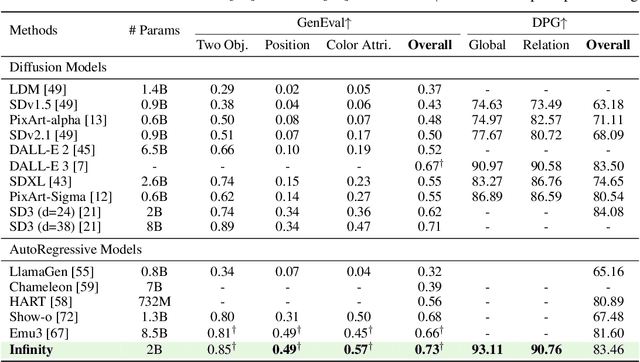

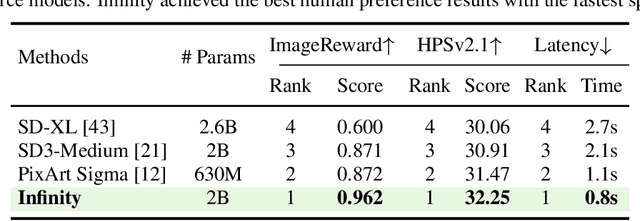

Abstract:We present Infinity, a Bitwise Visual AutoRegressive Modeling capable of generating high-resolution, photorealistic images following language instruction. Infinity redefines visual autoregressive model under a bitwise token prediction framework with an infinite-vocabulary tokenizer & classifier and bitwise self-correction mechanism, remarkably improving the generation capacity and details. By theoretically scaling the tokenizer vocabulary size to infinity and concurrently scaling the transformer size, our method significantly unleashes powerful scaling capabilities compared to vanilla VAR. Infinity sets a new record for autoregressive text-to-image models, outperforming top-tier diffusion models like SD3-Medium and SDXL. Notably, Infinity surpasses SD3-Medium by improving the GenEval benchmark score from 0.62 to 0.73 and the ImageReward benchmark score from 0.87 to 0.96, achieving a win rate of 66%. Without extra optimization, Infinity generates a high-quality 1024x1024 image in 0.8 seconds, making it 2.6x faster than SD3-Medium and establishing it as the fastest text-to-image model. Models and codes will be released to promote further exploration of Infinity for visual generation and unified tokenizer modeling.
A Semi-Supervised Approach with Error Reflection for Echocardiography Segmentation
Dec 01, 2024



Abstract:Segmenting internal structure from echocardiography is essential for the diagnosis and treatment of various heart diseases. Semi-supervised learning shows its ability in alleviating annotations scarcity. While existing semi-supervised methods have been successful in image segmentation across various medical imaging modalities, few have attempted to design methods specifically addressing the challenges posed by the poor contrast, blurred edge details and noise of echocardiography. These characteristics pose challenges to the generation of high-quality pseudo-labels in semi-supervised segmentation based on Mean Teacher. Inspired by human reflection on erroneous practices, we devise an error reflection strategy for echocardiography semi-supervised segmentation architecture. The process triggers the model to reflect on inaccuracies in unlabeled image segmentation, thereby enhancing the robustness of pseudo-label generation. Specifically, the strategy is divided into two steps. The first step is called reconstruction reflection. The network is tasked with reconstructing authentic proxy images from the semantic masks of unlabeled images and their auxiliary sketches, while maximizing the structural similarity between the original inputs and the proxies. The second step is called guidance correction. Reconstruction error maps decouple unreliable segmentation regions. Then, reliable data that are more likely to occur near high-density areas are leveraged to guide the optimization of unreliable data potentially located around decision boundaries. Additionally, we introduce an effective data augmentation strategy, termed as multi-scale mixing up strategy, to minimize the empirical distribution gap between labeled and unlabeled images and perceive diverse scales of cardiac anatomical structures. Extensive experiments demonstrate the competitiveness of the proposed method.
Creating a Microstructure Latent Space with Rich Material Information for Multiphase Alloy Design
Sep 04, 2024Abstract:The intricate microstructure serves as the cornerstone for the composition/processing-structure-property (CPSP) connection in multiphase alloys. Traditional alloy design methods often overlook microstructural details, which diminishes the reliability and effectiveness of the outcomes. This study introduces an improved alloy design algorithm that integrates authentic microstructural information to establish precise CPSP relationships. The approach utilizes a deep-learning framework based on a variational autoencoder to map real microstructural data to a latent space, enabling the prediction of composition, processing steps, and material properties from the latent space vector. By integrating this deep learning model with a specific sampling strategy in the latent space, a novel, microstructure-centered algorithm for multiphase alloy design is developed. This algorithm is demonstrated through the design of a unified dual-phase steel, and the results are assessed at three performance levels. Moreover, an exploration into the latent vector space of the model highlights its seamless interpolation ability and its rich material information content. Notably, the current configuration of the latent space is particularly advantageous for alloy design, offering an exhaustive representation of microstructure, composition, processing, and property variations essential for multiphase alloys.
Mamba2MIL: State Space Duality Based Multiple Instance Learning for Computational Pathology
Aug 27, 2024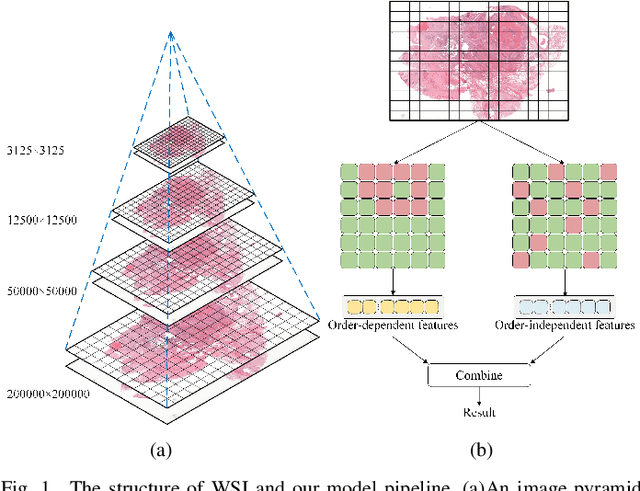
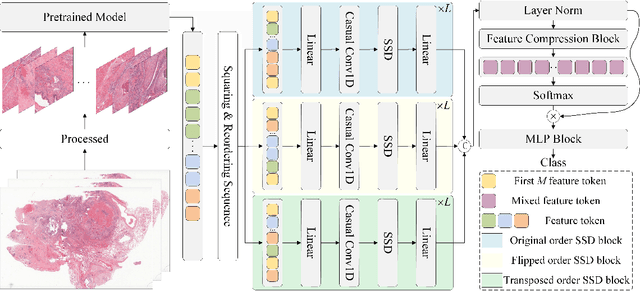
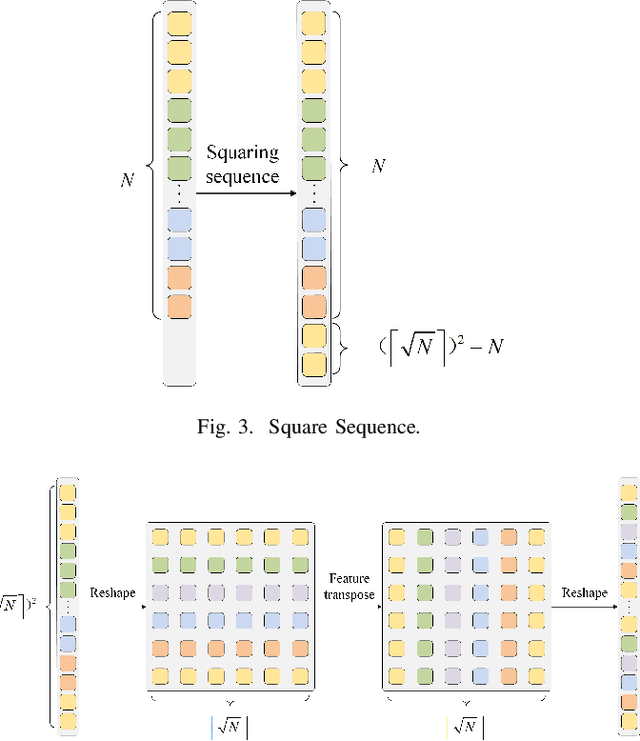

Abstract:Computational pathology (CPath) has significantly advanced the clinical practice of pathology. Despite the progress made, Multiple Instance Learning (MIL), a promising paradigm within CPath, continues to face challenges, particularly related to incomplete information utilization. Existing frameworks, such as those based on Convolutional Neural Networks (CNNs), attention, and selective scan space state sequential model (SSM), lack sufficient flexibility and scalability in fusing diverse features, and cannot effectively fuse diverse features. Additionally, current approaches do not adequately exploit order-related and order-independent features, resulting in suboptimal utilization of sequence information. To address these limitations, we propose a novel MIL framework called Mamba2MIL. Our framework utilizes the state space duality model (SSD) to model long sequences of patches of whole slide images (WSIs), which, combined with weighted feature selection, supports the fusion processing of more branching features and can be extended according to specific application needs. Moreover, we introduce a sequence transformation method tailored to varying WSI sizes, which enhances sequence-independent features while preserving local sequence information, thereby improving sequence information utilization. Extensive experiments demonstrate that Mamba2MIL surpasses state-of-the-art MIL methods. We conducted extensive experiments across multiple datasets, achieving improvements in nearly all performance metrics. Specifically, on the NSCLC dataset, Mamba2MIL achieves a binary tumor classification AUC of 0.9533 and an accuracy of 0.8794. On the BRACS dataset, it achieves a multiclass classification AUC of 0.7986 and an accuracy of 0.4981. The code is available at https://github.com/YuqiZhang-Buaa/Mamba2MIL.
SRAGAN: Saliency Regularized and Attended Generative Adversarial Network for Chinese Ink-wash Painting Generation
Apr 24, 2024
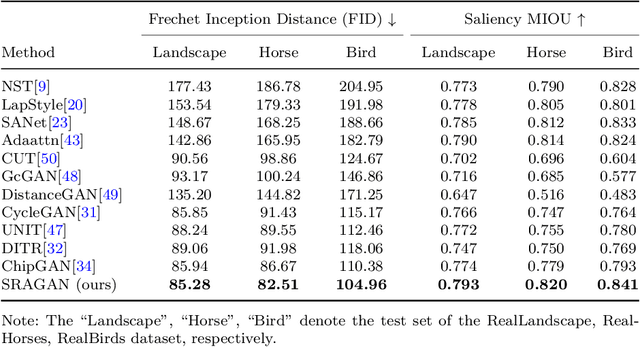


Abstract:This paper handles the problem of converting real pictures into traditional Chinese ink-wash paintings, i.e., Chinese ink-wash painting style transfer. Though this problem could be realized by a wide range of image-to-image translation models, a notable issue with all these methods is that the original image content details could be easily erased or corrupted due to transfer of ink-wash style elements. To solve or ameliorate this issue, we propose to incorporate saliency detection into the unpaired image-to-image translation framework to regularize content information of the generated paintings. The saliency map is utilized for content regularization from two aspects, both explicitly and implicitly: (\romannumeral1) we propose saliency IOU (SIOU) loss to explicitly regularize saliency consistency before and after stylization; (\romannumeral2) we propose saliency adaptive normalization (SANorm) which implicitly enhances content integrity of the generated paintings by injecting saliency information to the generator network to guide painting generation. Besides, we also propose saliency attended discriminator network which harnesses saliency mask to focus generative adversarial attention onto salient image regions, it contributes to producing finer ink-wash stylization effect for salient objects of images. Qualitative and quantitative experiments consistently demonstrate superiority of our model over related advanced methods for Chinese ink-wash painting style transfer.
Aerial Lifting: Neural Urban Semantic and Building Instance Lifting from Aerial Imagery
Mar 18, 2024
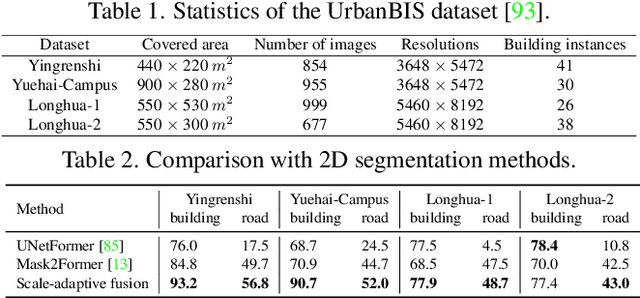


Abstract:We present a neural radiance field method for urban-scale semantic and building-level instance segmentation from aerial images by lifting noisy 2D labels to 3D. This is a challenging problem due to two primary reasons. Firstly, objects in urban aerial images exhibit substantial variations in size, including buildings, cars, and roads, which pose a significant challenge for accurate 2D segmentation. Secondly, the 2D labels generated by existing segmentation methods suffer from the multi-view inconsistency problem, especially in the case of aerial images, where each image captures only a small portion of the entire scene. To overcome these limitations, we first introduce a scale-adaptive semantic label fusion strategy that enhances the segmentation of objects of varying sizes by combining labels predicted from different altitudes, harnessing the novel-view synthesis capabilities of NeRF. We then introduce a novel cross-view instance label grouping strategy based on the 3D scene representation to mitigate the multi-view inconsistency problem in the 2D instance labels. Furthermore, we exploit multi-view reconstructed depth priors to improve the geometric quality of the reconstructed radiance field, resulting in enhanced segmentation results. Experiments on multiple real-world urban-scale datasets demonstrate that our approach outperforms existing methods, highlighting its effectiveness.
 Add to Chrome
Add to Chrome Add to Firefox
Add to Firefox Add to Edge
Add to Edge